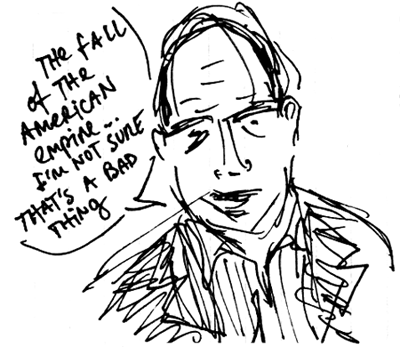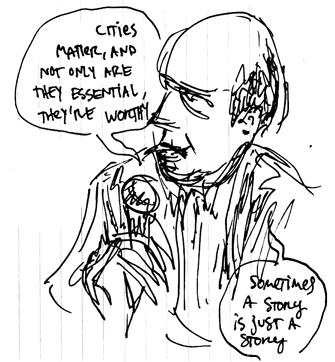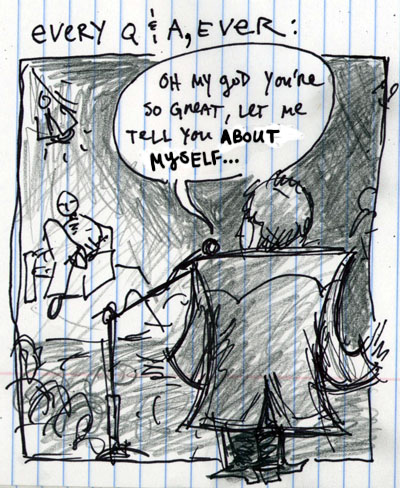
DAVID SIMON, CREATOR OF THE WIRE, AT THE UNIVERSITY OF TEXAS

Last night we went over to the Austin City Limits studio to see a Q&A with David Simon, former newspaper reporter and creator of the TV show The Wire. John Pierson was the moderator, and he did a really great job— he asked Simon intelligent questions and then sat and listened while Simon gave intelligent answers.
Discussed topics: the decline of the newspaper industry, journalism and Homer Bigart (“his method: ‘Hi, I’m an idiot and I can’t talk…please help me'”), dumbass editors looking for lame stories about “Dickensian” children (“Pulitzer Sniffing”), Iraq, No Child Left Behind, stealing from Greek Tragedy, the drug war, jury nullification, creative writing students (“my god, you guys are an industry”), books he hasn’t read (Brothers Karamazov), the creative use of profanity, The America That Got Left Behind, and of course, Baltimore (“my favorite character”), and The Wire.
As usual, I doodled and took a lot of notes:


Really cool night, and awesome to finally see the Austin City Limits studio. Thanks to Janet for inviting us!
Links:
UPDATE:
I wanted to point out Amanda Marcotte‘s post about the evening (relayed to me by Gerry Canavan):
Awards: A good excuse for fan wanking disguised as academic inquiry
It was a productive hour and a half of discussion, which is somewhat surprising, since they opened the floor to questions, which is usually an invitation for a bunch of assholes to pretend that everyone showed up to hear them talk instead of the speaker. There were a couple of people who asked questions where the question was a minor pretense for them to bloviate, but on the whole, the question askers were respectable and the questions were good.
It’s such a perfect, hilarious observation, a subject that Meg and I constantly complain about: too often Q&As are just a huge waste of time. This one wasn’t, but I drew a cartoon about it last night, anyways…I just didn’t post it. Here it is, now:

THE CORPORATION
This documentary was so good and so long (145 minutes!) that I made two pages of notes. Particularly great were the monologues by Noam Chomsky and Ray Anderson.
Link:
KEEP DREAMING.

SXSW 2008




Beautiful weather. Great venue. Fantastic lineup. Thought I was going to pee my pants waiting in line for a port-o-john, but ended up okay. We had a great spot in the shade:
Drew & Sonia (they’re getting married tomorrow!), my old friend Marty (4 years since I saw him!), his fiancee Marion (I finally got to meet her!), and Meg.
Marty with a $1 PBR and a free ice cream sandwich. Doesn’t get any better than that.
- ← Newer posts
- 1
- …
- 507
- 508
- 509
- 510
- 511
- …
- 635
- Older posts→







